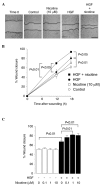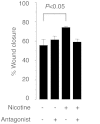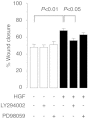Nicotine enhances hepatocyte growth factor-mediated lung cancer cell migration by activating the α7 nicotine acetylcholine receptor and phosphoinositide kinase-3-dependent pathway
- PMID: 26870265
- PMCID: PMC4727086
- DOI: 10.3892/ol.2015.3930
Nicotine enhances hepatocyte growth factor-mediated lung cancer cell migration by activating the α7 nicotine acetylcholine receptor and phosphoinositide kinase-3-dependent pathway
Abstract
Cigarette smoking not only promotes lung carcinogenesis, but it has also been demonstrated to promote the progression of lung cancer. Despite nicotine being a major component of cigarette smoke, it is not carcinogenic when acting alone. Instead, it is believed to function as a tumor promoter. Due to the fatal consequences of lung cancer being primarily associated with the processes of invasion and metastasis, the present study aimed to determine the effect of nicotine on the migratory activity of lung cancer cells. The effect of nicotine on the migration of lung cancer A549 cells was evaluated by a wound healing assay. Hepatocyte growth factor (HGF) was used as a pro-migratory stimulus. During several of the experiments, specific inhibitors of α7-nicotine acetylcholine receptor (α7-nAchR), phosphoinositide kinase-3 (PI3K) and extracellular signal-related kinase (ERK)1/2 were included. The phosphorylation levels of Akt and ERK1/2 were examined using a cell-based protein phosphorylation assay. It was observed that nicotine did not induce cell migration by itself, but that it instead promoted HGF-induced cell migration. The effects of nicotine were inhibited by the pretreatment of the cells with the α7-nAchR inhibitor, methyllycaconitine, and the PI3K inhibitor, LY294002. The mitogen-activated protein kinase/ERK kinase kinase inhibitor exerted modest, but non-significant inhibitory activity on the effect of nicotine. Nicotine did not induce Akt phosphorylation by itself, but instead promoted the HGF-induced phosphorylation of Akt. It was also observed that nicotine had no effect on ERK1/2 phosphorylation. The results from the present study indicate that nicotine, when alone, does not have a pro-migratory function, but instead enhances responsiveness to the pro-migratory stimulus emitted by HGF. The current study provides an insight into the mechanism of tumor promotion by demonstrating that nicotine and α7-nAchRs act in synergy with the HGF-induced PI3K/Akt signaling pathway, increasing the sensitivity of lung cancer cells to HGF, and thereby promoting cell migration, a vital step in invasion and metastasis.
Keywords: hepatocyte growth factor; lung cancer; migration; nicotine; phosphoinositide kinase-3; α7 nicotine acetylcholine receptor.
Figures




Similar articles
-
The role of α7-nAChR-mediated PI3K/AKT pathway in lung cancer induced by nicotine.Sci Total Environ. 2024 Feb 20;912:169604. doi: 10.1016/j.scitotenv.2023.169604. Epub 2023 Dec 27. Sci Total Environ. 2024. PMID: 38157907 Review.
-
Nicotine-Mediated Regulation of Nicotinic Acetylcholine Receptors in Non-Small Cell Lung Adenocarcinoma by E2F1 and STAT1 Transcription Factors.PLoS One. 2016 May 26;11(5):e0156451. doi: 10.1371/journal.pone.0156451. eCollection 2016. PLoS One. 2016. PMID: 27228072 Free PMC article.
-
Nicotine activates cell-signaling pathways through muscle-type and neuronal nicotinic acetylcholine receptors in non-small cell lung cancer cells.Pulm Pharmacol Ther. 2007;20(6):629-41. doi: 10.1016/j.pupt.2006.07.001. Epub 2006 Aug 18. Pulm Pharmacol Ther. 2007. PMID: 17015027
-
Role of α7-nicotinic acetylcholine receptor in nicotine-induced invasion and epithelial-to-mesenchymal transition in human non-small cell lung cancer cells.Oncotarget. 2016 Sep 13;7(37):59199-59208. doi: 10.18632/oncotarget.10498. Oncotarget. 2016. PMID: 27409670 Free PMC article.
-
Nicotine-mediated cell proliferation and tumor progression in smoking-related cancers.Mol Cancer Res. 2014 Jan;12(1):14-23. doi: 10.1158/1541-7786.MCR-13-0541. Epub 2014 Jan 7. Mol Cancer Res. 2014. PMID: 24398389 Free PMC article. Review.
Cited by
-
Epigenetic activation of hepatocyte growth factor is associated with epithelial-mesenchymal transition and clinical outcome in non-small cell lung cancer.J Cancer. 2019 Aug 28;10(21):5070-5081. doi: 10.7150/jca.30034. eCollection 2019. J Cancer. 2019. PMID: 31602259 Free PMC article.
-
Nicotine promotes brain metastasis by polarizing microglia and suppressing innate immune function.J Exp Med. 2020 Aug 3;217(8):e20191131. doi: 10.1084/jem.20191131. J Exp Med. 2020. PMID: 32496556 Free PMC article.
-
α7-Nicotinic Acetylcholine Receptor Promotes Cholangiocarcinoma Progression and Epithelial-Mesenchymal Transition Process.Dig Dis Sci. 2019 Oct;64(10):2843-2853. doi: 10.1007/s10620-019-05609-3. Epub 2019 Apr 4. Dig Dis Sci. 2019. PMID: 30949902
-
Metformin inhibits the migration and invasion of esophageal squamous cell carcinoma cells by downregulating the protein kinase B signaling pathway.Oncol Lett. 2018 Mar;15(3):2939-2945. doi: 10.3892/ol.2017.7699. Epub 2017 Dec 28. Oncol Lett. 2018. PMID: 29435022 Free PMC article.
-
Nicotine Induces Progressive Properties of Lung Adenocarcinoma A549 Cells by Inhibiting Cystic Fibrosis Transmembrane Conductance Regulator (CFTR) Expression and Plasma Membrane Localization.Technol Cancer Res Treat. 2018 Jan 1;17:1533033818809984. doi: 10.1177/1533033818809984. Technol Cancer Res Treat. 2018. PMID: 30384810 Free PMC article.
References
-
- www.iarc.fr/en/publications/books/wcr/wcr-order.php. [Oct 30;2015 ];World Health Organization: World Cancer Report. 2014 Accessed.
-
- American Cancer Society. http://www.cancer.org/acs/groups/content/@research/documents/webcontent/.... [Oct 30;2015 ];Cancer facts and figures. 2014 Accessed.
-
- Videtic GM, Stitt LW, Dar AR, Kocha WI, Tomiak AT, Truong PT, Vincent MD, Yu EW. Continued cigarette smoking by patients receiving concurrent chemoradiotherapy for limited-stage small-cell lung cancer is associated with decreased survival. J Clin Oncol. 2003;21:1544–1549. doi: 10.1200/JCO.2003.10.089. - DOI - PubMed
LinkOut - more resources
Full Text Sources
Other Literature Sources
Miscellaneous
